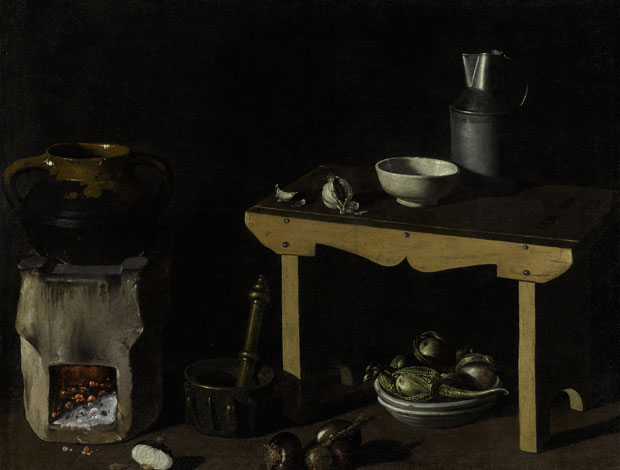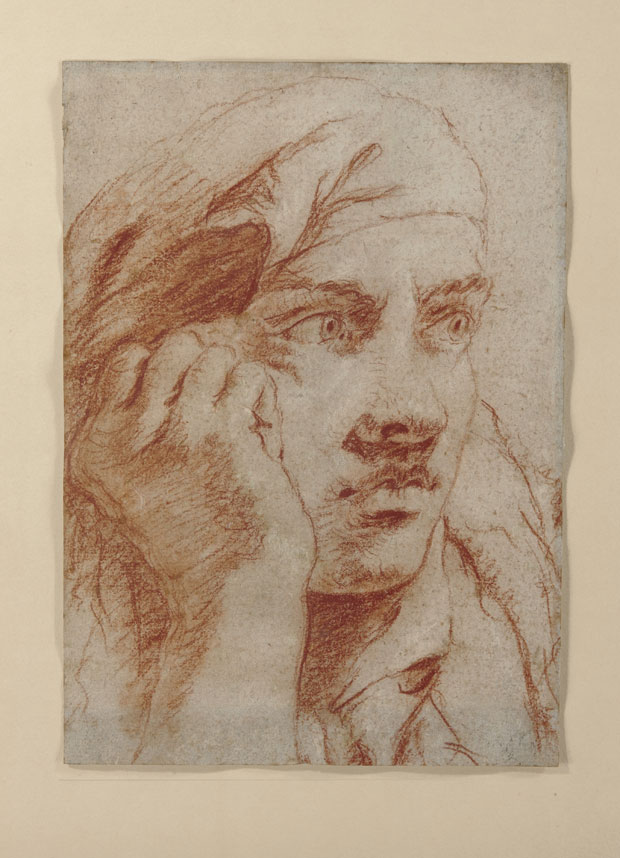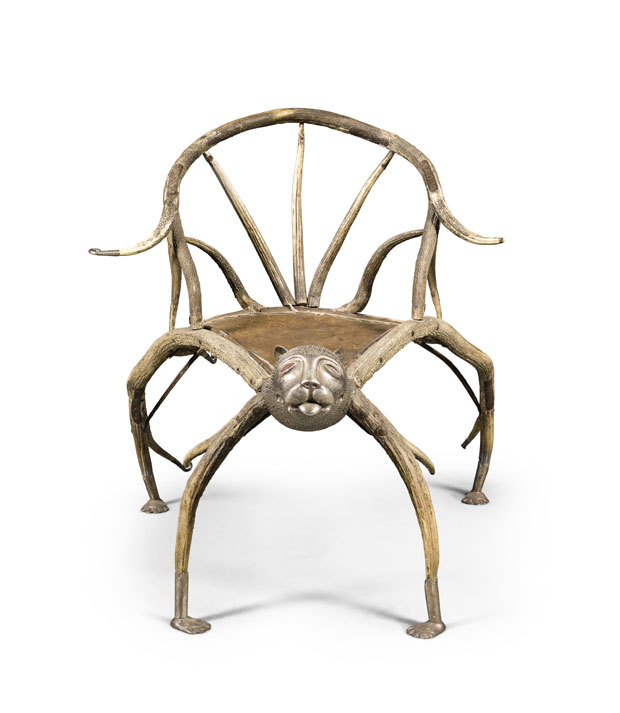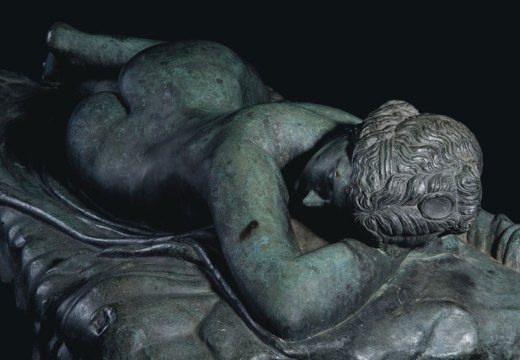A picture which has been intriguing scholars since its discovery in France in 1999 and its subsequent display in the Metropolitan Museum of Art, New York, and the Detroit Institute of Arts, now comes to auction at Sotheby’s New York on 25 January. Here the market will decide whether it regards it as a previously unrecorded early work by Diego Rodríguez de Silva y Velázquez, one of the greatest painters of all time.
It is what the Sevillian master Francisco Pacheco termed a bodegón, a type of painting of humble kitchen or pantry scenes generically named after the low-class taverns where people could eat. In 1611, the 12-year-old Velázquez was apprenticed to Pacheco, his future father-in-law, for six years. The kind of instruction the young artist received is indicated by his master’s treatise Arte de la pintura, in which Pacheco advocated the imitation of nature and everyday life in terms of ancient precedent.

Still life with a brazier, a mortar and pestle, aubergines on a plate, and a pitcher and white ceramic bowl resting on a rustic wooden table attributed to Diego Rodríguez de Silva y Velázquez (1599–1660) Sotheby’s New York ($1.5m–$2m)
There are nine bodegones generally agreed to be by Velázquez. All of them contain figures. Yet, as the American specialist of the Spanish still life, William B. Jordan, argues in his catalogue essay, there are compelling comparisons to be made between this painting and the famous Old Woman Cooking Eggs in the National Galleries of Scotland, and the London National Gallery’s Christ in the House of Martha and Mary, both of 1618. He cites in particular the oil-stained and dirty brazier, the glazed terracotta pottery highlighted by sparkling white impasto, the glow of brass, and the dull sheen of tin. Particularly close are the ways in which the artist has observed the dried, crinkled roots of the red onion and the brittle, crumbling skin of the garlic. Could this be an early bravura exercise in mimetic skill executed in Pacheco’s studio? A very similar composition executed by a different hand makes this a credible possibility.
These bodegones were hugely admired from the first, and widely copied, and by the end of the 19th century practically all of them had left Spain (five, incidentally, are in the UK). It is also known from Velázquez’s biographer Palomino that not all the artist’s works are known to us. This still life was in a private collection in Normandy since the 19th century until it was sold, as a work by Ignacio Arias, in 1999. When displayed in New York in 2002–05, the Met described it as ‘Spanish School, 17th Century’; by the time it showed in Detroit in 2015–16, the label was ‘Attributed to Diego Velázquez’. Sotheby’s has decided to err on the side of caution and stick to that description, which is why this canvas comes with an estimate of $1.5m–$2m rather than considerably more. The current auction record for the artist stands at $17m.
Bravura, too, is the chalk drawing Head of a Young Man offered at Christie’s New York on 24 January. The immediacy of this bold, staring head by the inimitable Venetian painter and draughtsman Giovanni Battista Tiepolo suggests that it was drawn from life. It belongs to a group of similar red and white chalk head studies executed on blue paper, examples of which are in the collections of the J. Paul Getty Museum and the Met. This choice of materials was something of a Venetian speciality, the deep, velvety red chalk and white highlights offering a striking contrast to the blue paper. Estimate $180,000–$220,000.

Head of a Young Man (c. 1750-60), Giovanni Battista Tiepolo. Christie’s New York ($180,000–$220,000)
Few vices afforded such opportunities for the display of wealth and taste as taking snuff. By the 18th century, insufflating pulverised tobacco leaves was far more socially desirable than smoking, and the taste for it generated all manner of handsome receptacles for the sharing of favoured blends. For this was essentially a social and ritualised pursuit. Apparently kept in the left pocket – body heat releases aroma and flavour – a snuff box would be flourished, tapped thrice to settle the powder, and then offered to companions, its interior, like as not, decorated with as much care as the exterior.
While perhaps best known are those bejewelled gold, hardstone or enamelled European examples that grace the sales of objets de vertu, they were also produced for the export market by the Chinese, although they preferred bottles for their own snuff. On 8 January, Christie’s offers what is believed to be the largest group of Chinese export porcelain snuff boxes ever collected, assembled over many decades by the late Lorraine and David Popowich of Philadelphia. The collection comprises some 30 examples of the 18th century decorated in famille rose, armorial or European subject enamels. There are novelty shapes too, such as the box in the shape of a gentleman’s shoe. Particularly appealing is a famille rose box with a coat of arms – probably of Cantrell – on the cover above basket weave-moulded sides enamelled with fruit and insects. Open it up and there is a European lady in a low-cut gown reclining in her boudoir (estimate $5,000–$8,000). Expectations range from $1,500–$10,000.
It seems that most of the Almanach de Gotha is represented in the roll call of consignors to Sotheby’s Of Noble and Royal Descent sale in London on 19 January. Of the wide-ranging works offered here, none perhaps is more extraordinary than the silver-mounted stag-antler chair, probably made in Kashmir or the Punjab in the 19th century. This comes from the family of General George Ramsay, 9th Earl of Dalhousie, who was Commander-in-Chief in India from 1829–32. It certainly appears to be unique – and something of a mystery.

Stag-antler chair (19th century), India, probably Kashmir or Punjab. Sotheby’s London (£5,000-£7,000)
The chair itself makes for a strange hybrid creature, its spidery stag-antler frame terminating in legs with silver paw feet and the apex of its hide seat mounted with a silver tiger mask. The tiger was the emblem of Tipu Sultan of Mysore, the implacable enemy of the British East India Company, who famously decreed: ‘Better to live one day as a tiger than a thousand years as a sheep.’ Dalhousie had served under Wellington who defeated Tipu in the Fourth Anglo-Mysore War of 1799, when the sultan died defending his capital. Family legend has it that the chair dates from this period.
Given the use of stag antler and the embossed boteh symbol – familiar to us as paisley – on the tiger’s temple, Sotheby’s catalogue entry proposes that the chair may have been a gift from Gulab Singh, the first Maharaja of Jammu and Kashmir, whom Dalhousie met in 1851 and noted ‘the presents on both sides really rich’. Its diminutive scale may also suggest that the chair was a gift from the young Maharaja Duleep Singh, with whom Dalhousie formed a close bond and exchanged many presents after the British annexation of the Punjab in 1849. Estimate £5,000–£7,000.
From the January 2017 issue of Apollo. Preview and subscribe here.
Unlimited access from just $16 every 3 months
Subscribe to get unlimited and exclusive access to the top art stories, interviews and exhibition reviews.












![Masterpiece [Re]discovery 2022. Photo: Ben Fisher Photography, courtesy of Masterpiece London](http://www.apollo-magazine.com/wp-content/uploads/2022/07/MPL2022_4263.jpg)
Has the Fitzwilliam got its rehang right?